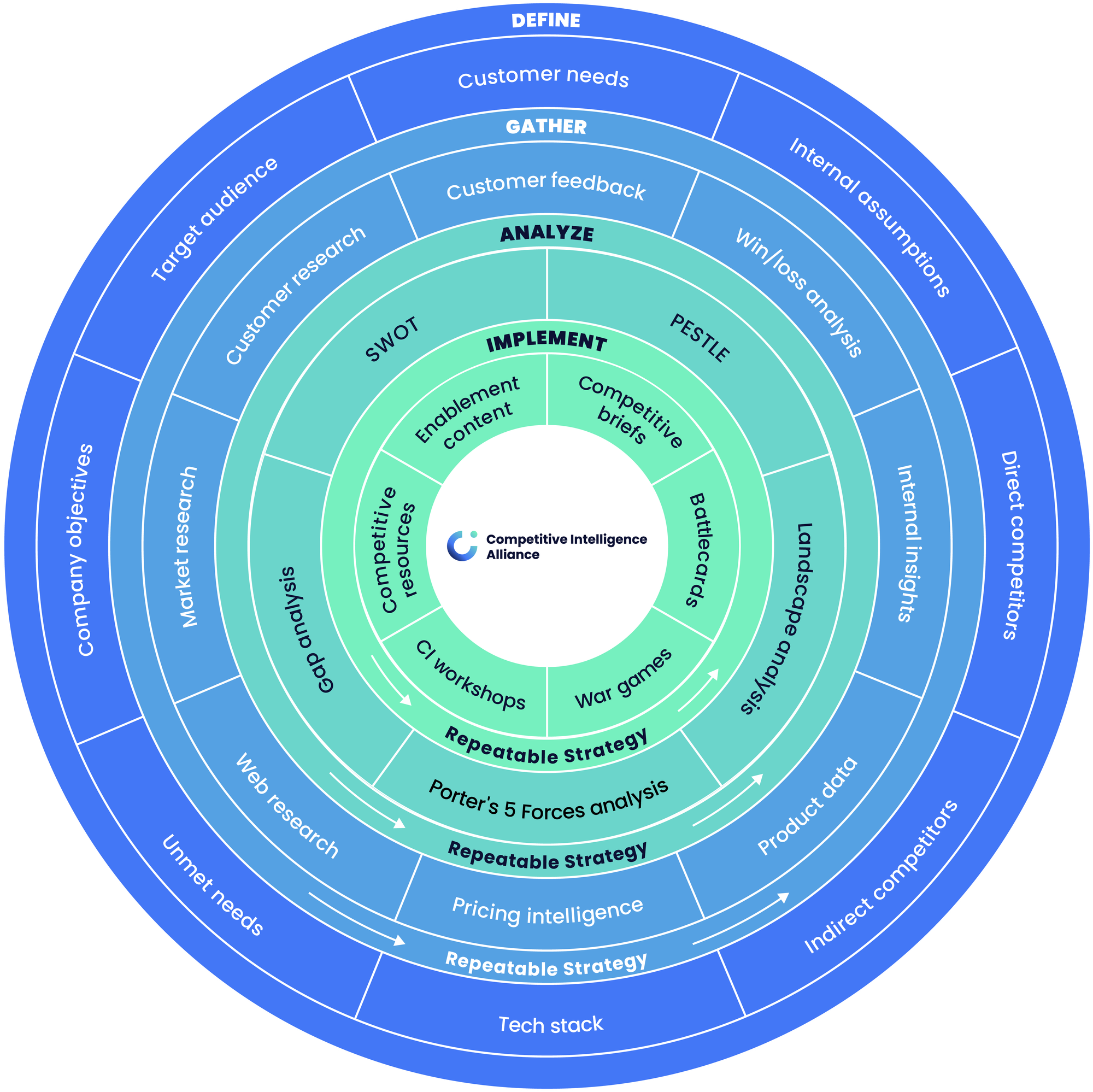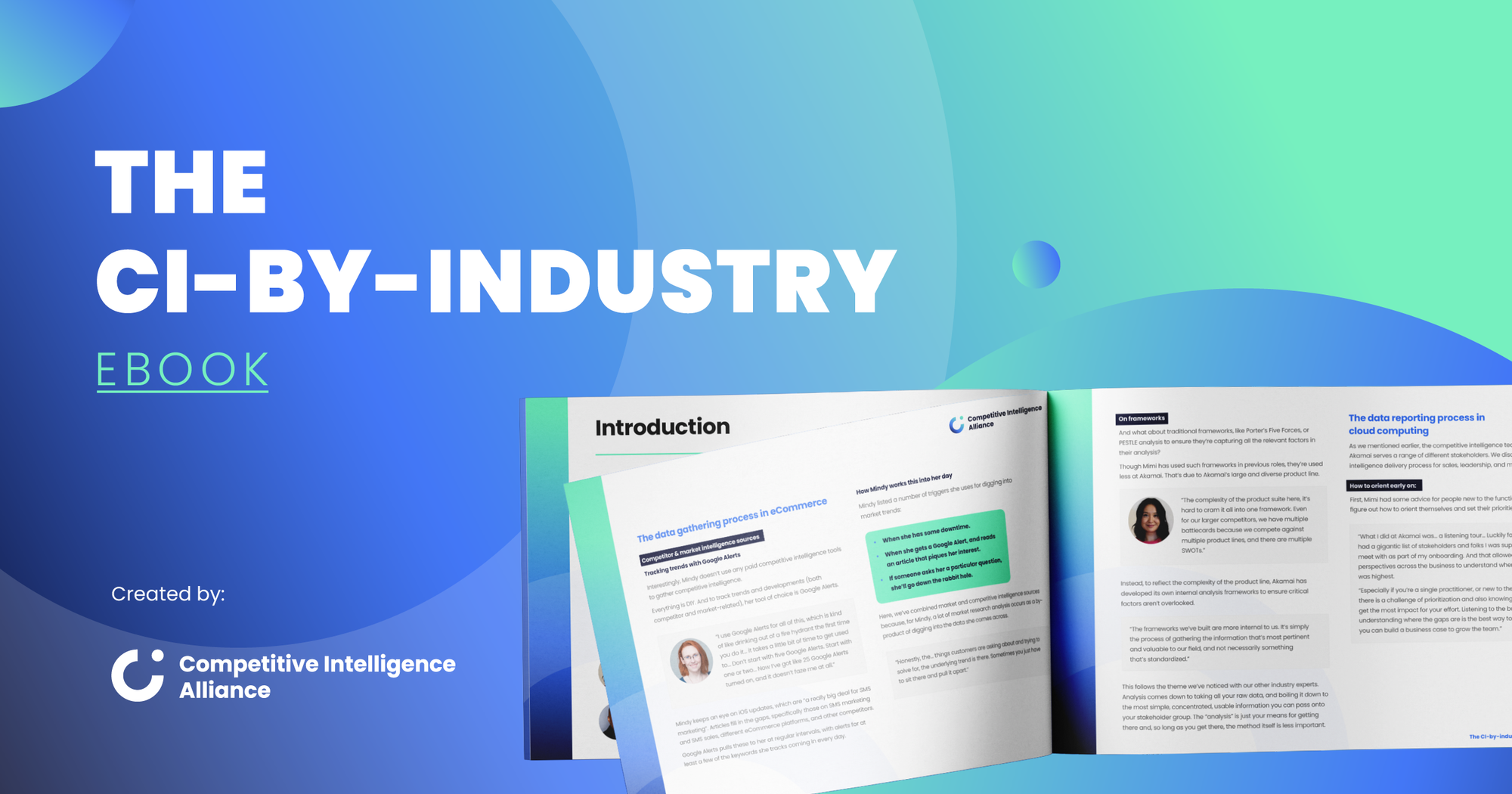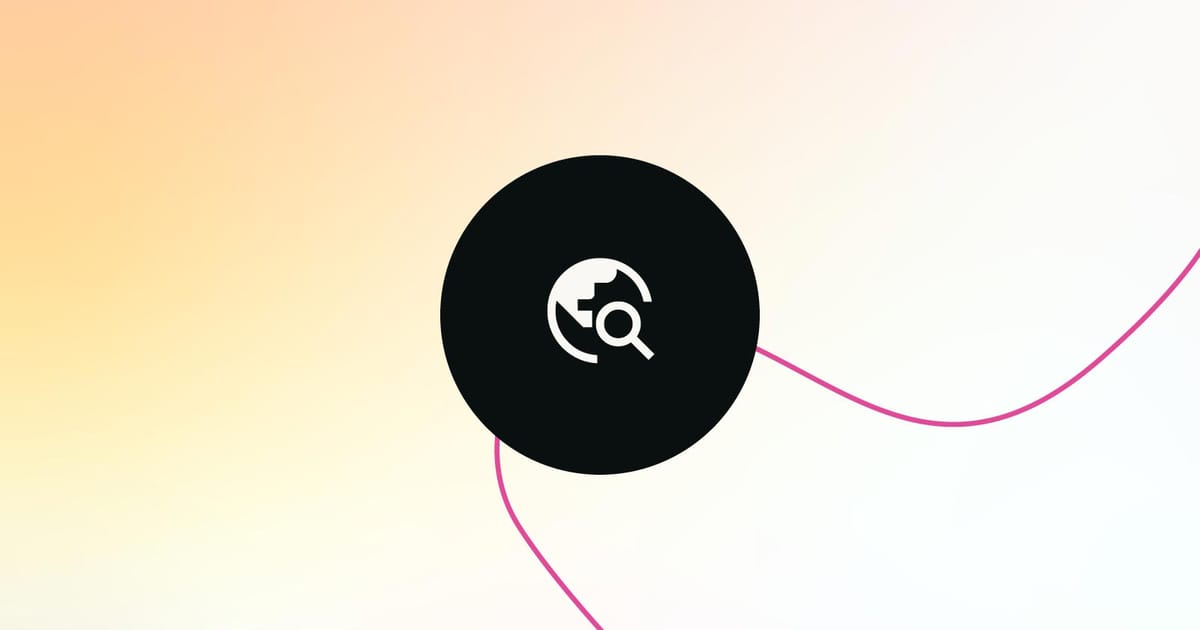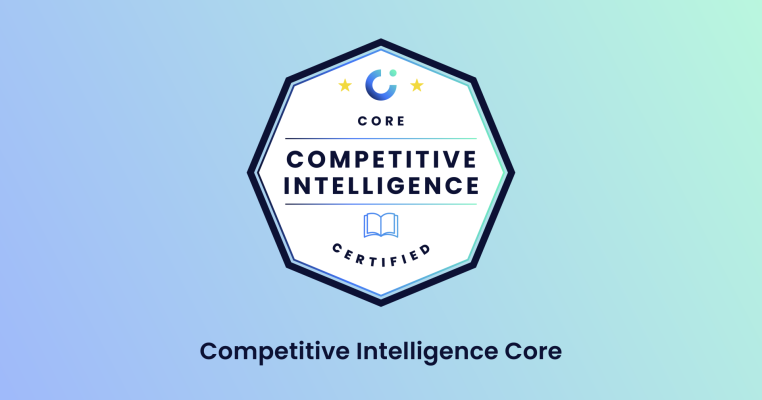What is competitive intelligence?
Competitive intelligence refers to the practice of collecting and analyzing data on your competitors, and delivering insights gleaned from that data to stakeholders around the business.
Good competitive intelligence work combines information learned about competitors with customer research to make sure insights align with what a business’ target market really wants. Combined, they inform a competitive strategy aimed at winning greater market share, and winning more deals.
Why is competitive intelligence important?
You learn what your customers want
At the heart of any competitive intelligence program, you’ll find a motivation to understand the customer. You have to understand what the market wants before you can provide it.
But speaking to prospective customers only gets you so far. Especially if you’re a step behind and losing customers to competitors.
Competitive analysis is about learning why customers go elsewhere and finding out why you lose.
Market research that helps you better understand your competitors, what they offer, and what customers like about what they offer, puts you in a better position to win competitive deals.
Some of what you find might surprise you, too. It’s not uncommon to hear your customers claim you don’t offer a feature that has actually been a part of your offering for some time.
Not communicating to your customers that your product meets their needs is the same as not meeting those needs at all.
It teaches you your competitors’ strengths and weaknesses
No one can be good at everything.
Even if you’re up against established giants with huge budgets, there are ways to play your position as the small upstart to your advantage. After all, who doesn’t love an underdog?
Without intel on your competitors, though, you’ll never uncover their strengths and weaknesses. Knowing where your competitors are weak gives you a chance to position yourself as the answer to their shortcomings. Knowing where they’re strong shows you ahead of time which fights you can’t win, where it’s sensible to conserve your energy, and where it’s worth making a stand.
Pretty useful, right?
Put another way, market intelligence gives you a clear view of the competitive landscape. And a clear view of the competitive landscape makes it obvious where your products should sit within it.
That means better positioning, a more persuasive offering for customers, and an increase in revenue.
“...understanding what competitors are helping other customers do can help you figure out whether or not you’re going to play against them in the market.”
Clint Buechler, Associate Manager of Growth Marketing at Rhino.
You’ll gain a deeper understanding of buyer motivations
Numbers don’t lie. And neither do customers…
At least, that’s what we’d like to believe. But some prospects don’t have a deep enough understanding of their own motivations to give you truthful answers. And if the data you get from customer interviews doesn’t reflect reality, it won’t get you results.
That’s where competitive intelligence comes in. Including information on your competitors gives you a more complete picture of your prospects’ motivations. And the more sources of data you have, the less power a few outliers have to skew the entire dataset.
This’ll give you peace of mind next time you’re worrying about the accuracy of the answers from your customer surveys.
CI also offers objectivity.
It helps you offset biases in your organization about your products. Seeing yourself from the market’s perspective lets you objectively identify what needs to change about your brand for you to win more business. Be it your product positioning, your messaging, or your content marketing strategy.
Uncover new market trends and opportunities
The modern marketplace is dynamic, disruptive, and fast-moving. It’s impossible to compete if you’re a step behind. When you’re gathering competitive intelligence day in and day out, though, it’s impossible not to keep up to speed with the latest goings-on.
When you’ve got an active, successful competitive intelligence program, you’re in a great position to spot new industry trends and opportunities as they emerge.
You might notice your target audience migrating to products with a common feature. If your product doesn’t have this feature yet, you can act swiftly to make developing that feature a priority.
CI helps you anticipate your competitors’ next moves
Just as CI helps uncover emerging market trends and opportunities, it also alerts you to emerging threats. Having your finger on the pulse of the market makes it possible to anticipate your competitors’ next moves.
When you’re one step ahead, and you capitalize on your competitor’s weaknesses, you’ll neutralize competitor strategies as fast as they can devise them.
Of course, you can’t predict everything. But this will help you get and stay ahead of the competition when new products and services catch your customers’ eyes.
You can build a sustained competitive advantage
When you have a competitive advantage, you’re well-positioned to win more customers than your competitors. But your edge in any highly competitive endeavor is small. And your competitors will be working around the clock to replicate your advantage and diminish your lead.
So how do you make your advantage sustainable?
It starts with data collection. Collecting information on your competitors helps you establish a baseline of behavior. If they move away from this baseline, you’ll know they’re up to something.
These behavioral shifts can act as early warning signals, alerting you before competitors make a move on your advantage.
But since CI uncovers opportunities too, it can show you where your competitors’ advantages lie.
This can inform strategic decisions around new advantages and possibilities that your competitors haven’t yet exploited, or have left undefended. Make these advantages your own and you’ll acquire more market share and increase your brand’s longevity.
CI helps you prioritize, with a huge impact on revenue
There’s an infinite amount of work in all organizations. You’ll never be able to do it all. Such time constraints make prioritization crucial.
CI helps here too. It helps you prioritize and make more informed business decisions.
It teaches you what your customers value most, and helps you filter out the competitive battles you stand no chance of winning. You’re left with (i) the areas you’re already knocking it out of the park, and (ii) the areas where a strategic tweak or two can have landslide consequences for your bottom line. For better or worse.
These areas are like swing states. A few votes in either direction could decide the entire election. That is, the vote the customer casts with their dollars and cents.
In competitive deals, just a few persuasive points in your favor could mean thousands more prospects choosing you over a competitor. Even if it’s a close-run thing, they can only pick one.
So, depending on your average deal size, these are massively leveraged opportunities to impact your organization’s bottom line.
Competitive intel helps you strengthen strategies across the business
A great CI strategy will go on to inform a ton of other strategies across the business.
From your product positioning strategy to your content marketing strategy, even your pricing and brand messaging. You can improve them all when your competitive intelligence program gets underway.
The end result of all this? A stronger product, a better customer experience, more won deals, and increased revenue. All thanks to competitive intelligence.
How it works: the competitive intelligence cycle explained
Competitive intelligence (CI) is not a one-and-done task. It’s not even really a series of steps.
No, competitive intelligence is best explained as a cycle. New intel on your competitors pops up all the time. It’s your job to capture it, analyze it, and figure out what it means for your business. From there, you’ll deliver those insights in the format best suited for the internal customers (stakeholders) you’re serving.
The stages of the cycle are, perhaps, best outlined like this:
- Orientation
- Data gathering
- Data analysis and processing
- Data reporting
- Actioning
The first stage, orientation, involves getting in sync with the needs of the business, the goals of its leaders, and the needs and wants of your internal customers.
While you don’t strictly have to repeat this orientation process every time you go around the CI cycle, it’s worth gathering feedback from the teams you’ve served so you can improve your ability to serve them in the future.

The value comes from your ability to offer accurate, considered points of view on what your intel means for the business, and advice on how to alter key components of strategy, including product development, product messaging, and product positioning.
The next few stages, gathering, analysis, and reporting are pretty self-explanatory. You gather the data (more about that in a subsequent section), you analyze it (read: think about it and what it means in light of what you know already), and distill that into key takeaways. After all that, you report these takeaways to relevant groups.
The final stage, actioning, won’t necessarily be up to you as the CI pro. But you’ll want to make very sure you check that your stakeholders are acting on the information you’re giving them.
For example, you might distill your findings down into handy battle cards and other sales enablement content for your sales team, but if they don’t use these assets when the time comes, their win rates won’t improve. Tracking the adoption rate of your enablement content lets you tie this metric back to win rates, so you can track whether your content is having the impact it should.
Looking for more information on the CI cycle? Here’s the competitive intelligence cycle explained in 5 steps .
Types of CI
There are both multiple types of competitive intelligence work, and multiple types of competitive intelligence data.
First, we’ll discuss the various types of competitive intelligence work you can do.
Types of competitive intelligence work: strategic vs. tactical
There are two main types of competitive intelligence work: tactical and strategic.
Tactical
Tactical CI work is more short-term, and more reactive, than strategic CI. It’s about what’s happening right now, what has happened recently, and what you should do about it as a business.
Usually, tactical competitive intelligence work’s aims can be described as “quick wins”. How can we enable sales to win more deals – today? Can we tweak our pricing to persuade more prospective buyers – today? A competitor just released a new feature, what must we do to remain competitive – today?
Strategic
Strategic competitive intelligence work, by contrast, concerns itself with longer-term business objectives.
It’s focused on broader market and industry trends, and it looks to advise overarching business strategy. Such advice steers a business toward capitalizing on market opportunities, sidestepping threats in the competitive landscape, and thriving into the future with a sustained competitive advantage.
Market intelligence, changing consumer behavior, and longer-term signs from competitors about the shifting landscape, become much more important in this kind of CI work, and those performing it are likely to report directly to leadership.

CI-by-Industry eBook
Download your copy to learn...
- 😰 Why field intelligence can be dangerous, and how to use it the right way. (Page 24)
- 🙅♂️ Why you should think twice before having reps from this team on a win/loss call. (Page 24)
- 🤖 The truth about automation, and how much time tools can really save you. (Page 22)
- 🤯 The surprising key skill every one of our industry experts said was crucial for CI success. (Page 66)
Types of competitive intelligence data: internal vs. external
The types of competitive intel you can collect and work with can be broadly separated into two categories: internal and external.
Internal data
Internal data is just external data someone else in your business has already collected. Since the work has already been done, it’s most practical to find this information within the business. For this reason, it’s referred to as internal data.
What’s more, it benefits you to actively encourage people to collect as much data as they can on your behalf. Competitive intelligence teams are usually small (when there’s more than one person dedicated to the role at all). Resources are, therefore, limited.
The experts we’ve spoken to consider it a best practice to “crowdsource” your competitive intelligence efforts, building a “culture of compete” where everyone considers it a shared responsibility to keep an eye on competitors, and report intel back.
Here’s a list of the places inside the business where you can find intel:
- Your CRM.
- Your sales and customer success reps.
- Your leadership team.
External data
External data can be further categorized.
These subcategories are best considered through the means of acquiring them. There is necessarily some overlap between types of external data. In the next section, we’ll examine these methods in detail.
They include:
- Customer research data.
- Win/loss data.
- Competitor announcements.
- Wider market and industry intelligence.
- Information about a competitor’s various strategies (content, PPC, marketing, positioning, etc).

Best competitive intel gathering methods and sources
Here’s a list of data gathering methods you’ll want to become familiar with:
- Win/loss interviews
- Customer research
- Competitor websites
- Competitor help and support documentation
- Competitive SEO analysis
- Social media
- Community forums
- Press releases and news articles
- Internal data (SMEs, CRM, etc)
1) Win/loss interviews
Win/loss data is powerful.
What makes it so special, you ask?
With the best will in the world, foresight can only get you so far. If you want the full story about why you’re winning and losing deals, you need to speak with the people who’ve actually been through your funnels, and experienced your buyer journey first hand.
The feedback they can give you about what worked well, what didn’t, and what ultimately influenced their purchasing decision can bear fruit in surprising (and profitable) ways.
It’s not always easy, or quick, to perform these interviews. You have to source willing participants, devise questions, figure out who’s actually going to conduct the interviews for the best (read: most honest) responses… but get it right, and it’s worth it.
What’s more, you can learn what your prospects thought about competitor products, and what their experience of having those competitors court them was like.

2) Customer research
Building on the theme begun with win/loss analysis, your customers can tell you a lot.
But they don’t have to have experienced your buyer’s journey for them to teach you a thing or two.
As much as you might feel you know already, markets and customer requirements are dynamic. The only way to keep your finger on the pulse of what your customers want is to check in with them regularly.
Interviews and surveys are two great ways to do this. You need to understand the emotional pain points your customers are experiencing, so you can craft the best solutions for those problems on the market.
But wait… what does this have to do with competitors?
Well, customers in the market for a solution like yours have probably already checked out your competitors. In your customer research, you can ask customers which competitors they’ve got an eye on, which they think are good value, and which they believe to have a strong brand or effective marketing strategies.
3) Competitor websites
This is perhaps the most obvious source of competitive intelligence: the competitor’s website.
Almost all modern businesses have an online presence, and that includes a website. A website where they’ll post product updates, pricing information, articles aimed at their target audience, and all sorts of other information that tells you what’s important to them (and, therefore, what they’re prioritizing for strategic reasons).
However, not all businesses use their online presence in the same way. If you’re in SaaS, you’re probably in luck. It’d be surprising if all your competitors didn’t have detailed, thoroughly built-out websites.
But it’s not a given. Some SaaS company websites are a single landing page. That’s it. They’ve got one funnel, a simple product offering, and the website barely extends (if at all) past the homepage. When your competitor is shy about posting lots of publicly available information on their website, you’ll have to look elsewhere.

4) Competitor help and support documentation
Okay, so you’ll find this on your competitors’ websites too. But it’s such a great source of powerful intel, we’re going to give it its own section.
What makes it so powerful?
Product documentation isn’t written for prospects. You’ll find no marketing speak here. Instead, you’ll get a plain language breakdown of how the product works, aimed at making things as clear as possible for existing customers.
This gives you a freshly polished window through which to get a good look at the inner workings of your competitors’ products.
Even better, if you can find them, product changelogs will give you a play-by-play of what has changed (and potentially even what is planned for future releases) on a version-by-version basis.
5) Competitive SEO analysis
Also related to your competitor’s website, but specifically to do with their content strategy, don’t make the mistake of thinking competitive SEO analysis is only for content and marketing teams.
Luckily for you, though, these teams might already be doing this work. Where they are, you can take their findings and incorporate them into your own analysis.
Where they’re not, it pays to do it yourself. Tools like SEMrush or Ahrefs are a huge help for this. But if your budget isn’t exactly generous, you can still gain some insights manually.
Check out the types of articles your competitors are writing. What kinds of queries are they targeting? Are they looking to answer informational queries (with pages like the one you’re reading right now?) Where they are, look to learn more about the kinds of questions they’re looking to answer.
Remember: quality content is time-consuming to produce. If your competitors are investing in it, there’s a reason. The types of queries they’re targeting, even the types of call-to-action you see on those pages, can tell you a lot about where their priorities lie.
6) Press releases and news articles
While your competitors’ websites are perhaps the means of acquiring competitive intel that’s closest to the source, press releases and industry news articles might just be the next best thing.
Official statements and press releases relating to new hires and product releases are a great place to start.
Google Alerts should pick these up with ease, so even if you don’t have the budget for paid competitive intelligence tools, this is one source of intel that’s available to everyone.

This might be low-hanging fruit, but it’s not a source you want to overlook. All your competitors will have their eyes on these releases, and you don’t want to fall behind because you missed something that was easy to catch.
7) Social media
While social listening tools exist to make monitoring social media for mentions of your competitors easier, manual monitoring is still worth your time.
X, LinkedIn, Facebook, even Instagram… all social media platforms can serve as sources of competitive intel.
But it gets better.
Social media offers more than one type of competitive intelligence.
First, if your competitors have a presence on that platform, you can follow them and monitor their account for announcements and clues about their strategy.
Second, even if a competitor isn’t active on a particular platform, conversations can start that offer insights into what the market thinks about them and their products.
Some of these users might be customers of a given competitor, too. These users might let slip updates about what the competitor has planned, what’s in the product/feature pipeline, and other competitive goodies.
As anyone who has spent any time on social media knows, conversations tend to be candid, polarizing, and no-holds-barred. If you want a window into what users think about your competitors (and even you, and your own products), social media is a great place to go.

8) Community forums
It’s not just the big social media players, though, that can offer a candid look at what your target audience thinks about competitors.
Community forums on platforms like Reddit, Quora, even Slack, can feature question-and-answer format conversations with detailed breakdowns of feature sets, pricing information, and overall customer experience.
Since these platforms lend themselves better to long-form conversation than the social media outlets discussed in the previous section, these forums can be a great place to go if you need a detailed look at community sentiment.
9) Internal data (CRM, internal SME interviews)
Remember: Your “internal data” sources are perhaps your most efficient means of acquiring intelligence.
Interview internal subject-matter experts, as well as your customer-facing reps (read: sales and customer success), for a sense of what they’re hearing on the front lines.
Your CRM is also a goldmine of competitive information. When you can’t go to the source and speak to prospects directly with primary customer research and win/loss interviews, these sources are an excellent backup, and are much less costly.
Competitive intelligence tools
Remember: The value you can offer as a competitive intelligence professional largely comes down to how you can use what you learn to inform overall business strategy, including:
- How your sales team approaches deals where your products are up against those of a close competitor;
- How your leadership team approaches strategic decision-making;
- How your product marketers and larger marketing team builds out its competitive positioning and messaging;
- How your product team builds out its product roadmap and prioritizes its feature ideas and requests.

That means taking the data you’ve gathered and teasing out its ramifications for your business. Then, once you’ve found these, working closely with stakeholders to deliver them exactly what they need to make them (and the business at large) more effective.
All this to say, the data gathering part itself isn’t where the value comes from. It’s everything that happens afterwards that’s important. If you can automate the data gathering without missing anything (or even while capturing more data, more efficiently than you’d have been able to do manually), there’s a massive value-add to you and your role as the CI pro.
Competitive intelligence tools that automate all or part of the intelligence gathering process (and, in some cases, even convert your insights into particular formats, like battle cards), are a great investment for businesses with the budget to spare.
Here’s a quick breakdown of essential software tools for your competitive intelligence tech stack .
For a comprehensive list, grab a free copy of the Competitive Intelligence Tools of Choice Report .
Give yourself an unfair advantage
Our newest competitive intelligence course lifts the lid on the frameworks and processes experts use to deliver impactful intel with confidence.
You can expect:
- A 100% self-paced and online course packed with competitive wisdom so you can stop worrying and start winning.
- Bonus features from established competitive professionals to give you an unfair advantage.
- 6 downloadable, customizable templates and frameworks that make analysis a cinch.

Competitive Intelligence: Core
We'll show you how to:
- 👑 Lead development of your org’s all-important competitive positioning.
- 🦾 Master CI’s essentials, including its most powerful research techniques.
- 🚀 Arm sales and customer success with intel to skyrocket win rates and turn down churn.
- 🧠 Offer leaders critical intel that informs their decision-making and strategy.
- 📈 Elevate CI’s role within your org to ensure career progression.






.png?v=09cf73b4b5)